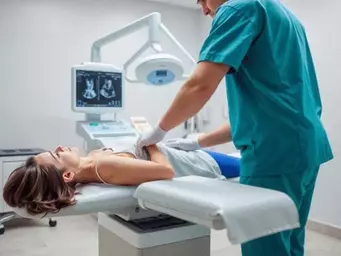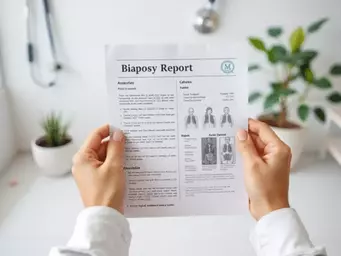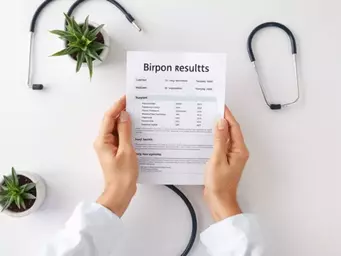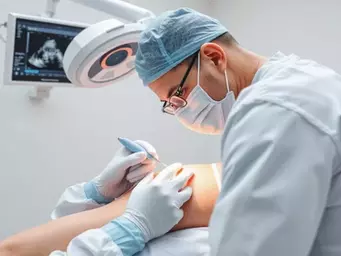Understanding the process of an image-guided breast biopsy can significantly alleviate anxiety and empower you to take control of your healthcare journey. As you prepare for this procedure, knowing what to expect can make all the difference.
What You Will Learn
- Image-guided breast biopsies use advanced imaging technology for precise tissue sampling.
- There are three main types of biopsies: stereotactic, ultrasound-guided, and MRI-guided, each with unique advantages.
- Understanding the benefits and risks of each biopsy type can help reduce patient anxiety.
- Preparation and communication with your healthcare provider are crucial for a smooth biopsy experience.
- Post-procedure care and following recovery instructions are essential for comfortable healing.
- Utilizing support systems and educational resources can empower you throughout your healthcare journey.
Comparing Image-Guided Breast Biopsy Types and Their Key Aspects
This visual outlines the three primary types of image-guided breast biopsies—Stereotactic, Ultrasound-Guided, and MRI-Guided—and compares their key characteristics across essential aspects like precision, invasiveness, and ideal use cases.
Stereotactic Biopsy
- Method: Uses mammographic images.
- Precision: High, pinpoints microcalcifications.
- Invasiveness: Minimally invasive.
- Recovery: Quicker recovery.
- Comfort: Generally low risk, minimal discomfort.
Ultrasound-Guided Biopsy
- Method: Uses real-time ultrasound imaging.
- Precision: High, real-time visualization.
- Invasiveness: Minimally invasive.
- Recovery: Quicker recovery.
- Comfort: Often more comfortable, reduces need for additional imaging.
MRI-Guided Biopsy
- Method: Uses detailed MRI images.
- Precision: Excellent, for hard-to-find lesions.
- Invasiveness: Minimally invasive.
- Recovery: Similar to other types.
- Comfort: Best for complex cases, may require more preparation.
Understanding the Image-Guided Breast Biopsy Procedure
When it comes to diagnosing breast conditions, understanding the image-guided breast biopsy procedure can significantly reduce your anxiety. This minimally invasive technique allows healthcare providers to obtain tissue samples with precision. It’s essential to know what to expect, as this knowledge can empower you to engage more actively in your healthcare decisions.
Essentially, an image-guided breast biopsy involves using imaging technology to guide the physician in extracting tissue samples from suspicious areas in the breast. These samples are then analyzed to determine whether there's any cause for concern, such as cancer. This proactive approach enables early intervention, which is crucial in breast health.
What is an Image-Guided Breast Biopsy?
An image-guided breast biopsy is a method that employs imaging tools to enhance the accuracy of tissue sampling. This procedure is particularly important for locating and targeting areas that are not palpable during a physical examination.
- Precision: The imaging technology ensures that the biopsy is taken from the correct location.
- Minimally Invasive: This technique is less invasive than traditional surgical biopsies.
- Quicker Recovery: Patients typically experience a faster recovery time.
Understanding the distinction between different biopsy methods can help you make informed choices. Remember, being proactive about your health is a positive step!
Types of Image-Guided Breast Biopsies: Stereotactic, Ultrasound, and MRI
There are primarily three types of image-guided breast biopsies: stereotactic, ultrasound-guided, and MRI-guided. Each type has unique advantages depending on the specific circumstances and the characteristics of the lesion. For instance, ultrasound-guided breast biopsies are particularly effective for lesions visible on ultrasound.
- Stereotactic Biopsy: This method uses mammographic images to pinpoint the location of the abnormality.
- Ultrasound-Guided Biopsy: Here, ultrasound imaging helps visualize the breast tissue in real-time, facilitating accurate needle placement.
- MRI-Guided Biopsy: This approach provides detailed images of the breast, which is particularly useful for detecting hard-to-find lesions.
Each method aims to enhance your comfort while maintaining accuracy in the biopsy process. Your healthcare provider will discuss which option is best suited for your situation.
Comparing Biopsy Types: Risks, Benefits, and Patient Comfort
Understanding the differences in biopsy types can help alleviate concern. Each method has its risks and benefits, as well as implications for patient comfort. The Mayo Clinic provides comprehensive information on what to expect from these procedures.
- Stereotactic Biopsy: Generally low risk, minimal discomfort, with quick results.
- Ultrasound-Guided Biopsy: Offers real-time imaging, reduces the need for additional imaging, and is often more comfortable.
- MRI-Guided Biopsy: Best for complex cases, though it may require more preparation time.
Knowing what to expect can ease your mind, and the benefits of each method can help you feel more confident in the care you're receiving.
Role of Imaging Techniques in Breast Biopsy: Mammography, Ultrasound, and MRI
The imaging techniques used during a breast biopsy play a crucial role in ensuring accuracy. Mammography, ultrasound, and MRI all have their unique contributions to this process. For more details on the importance of these techniques, the National Breast Cancer Foundation offers valuable insights into breast cancer biopsies.
- Mammography: Helps identify abnormalities in breast tissue through X-ray imaging.
- Ultrasound: Offers real-time imaging, enabling doctors to see the structure of the breast more clearly.
- MRI: Provides detailed images, particularly beneficial for evaluating complex cases.
Each imaging technique complements the others, ensuring that you receive the most thorough evaluation possible. By understanding these components, you can feel more secure in the biopsy process.
Pro Tip
Did you know? Staying well-hydrated before your biopsy can help ease tension and promote quicker recovery. Drinking water can also help improve the quality of your tissue samples, providing clearer results for your healthcare provider.
Frequently Asked Questions About Image-Guided Breast Biopsies
Here are some common questions to help you better understand image-guided breast biopsies:
What is an image-guided breast biopsy?
An image-guided breast biopsy is a minimally invasive procedure that uses imaging technology (like mammography, ultrasound, or MRI) to precisely locate and extract tissue samples from suspicious areas in the breast for analysis.
What are the main types of image-guided breast biopsies?
The three main types are stereotactic biopsy (uses mammogram images), ultrasound-guided biopsy (uses real-time ultrasound), and MRI-guided biopsy (uses detailed MRI images). Each is chosen based on the specific characteristics of the breast abnormality.
How do these biopsies differ in terms of invasiveness and recovery?
All three types are considered minimally invasive compared to traditional surgical biopsies, resulting in quicker recovery times. The primary differences lie in the imaging method used and their suitability for different types of lesions.
What are the benefits of an ultrasound-guided biopsy?
Ultrasound-guided biopsies offer real-time visualization, which can reduce the need for additional imaging. They are often more comfortable for patients and highly precise for lesions visible on ultrasound.
Why might an MRI-guided biopsy be recommended?
An MRI-guided biopsy is typically recommended for complex cases or when abnormalities are difficult to find with mammography or ultrasound, as MRI provides very detailed images. It may require more preparation time due to the nature of MRI scanning.
How can I prepare for my breast biopsy?
Preparation typically involves following your healthcare provider's instructions, which may include avoiding certain medications, staying well-hydrated, and understanding the specific procedure you will undergo. Open communication with your doctor is key.
What should I expect during recovery?
Recovery is generally quick, with most patients experiencing minimal discomfort. It's crucial to follow all post-procedure care instructions provided by your healthcare team to ensure proper healing and avoid complications.
Summarizing Your Breast Biopsy Journey
As you wrap up your breast biopsy journey, it’s essential to reflect on the experience. Each step—from preparation to recovery—plays a vital role in your health and peace of mind. Here are some key takeaways to help ensure a smooth process:
- Preparation is Key: Following your pre-biopsy checklist can significantly reduce anxiety.
- Understand Your Procedure: Familiarize yourself with the type of biopsy being performed and what to expect.
- Communicate Openly: Don't hesitate to ask your healthcare provider any questions that arise.
- Post-Procedure Care: Follow recovery instructions closely to aid healing and comfort.
By keeping these considerations in mind, you can approach your biopsy with greater confidence and clarity. Remember, knowledge is power!
Encouragement and Support for Patients
Facing a biopsy can be daunting, but you are not alone! At What Is A Biopsy, we understand the emotional rollercoaster that comes with medical procedures. It's perfectly normal to feel anxious or uncertain, but just know that support is available:
- Lean on Your Support System: Reach out to family, friends, or support groups who can offer comfort.
- Stay Informed: Educate yourself about the procedure to feel more empowered.
- Practice Self-Care: Engage in activities that promote relaxation, like meditation or gentle exercise.
Each step you take is a step toward better health. You’ve got this, and we’re here to help you navigate the journey!
Resources for Patient Education and Support
To further aid your understanding and preparation, we offer a range of resources tailored for patients:
- Comprehensive Articles: Our doctor-reviewed content covers everything from procedures to recovery tips.
- Q&A Guides: Find answers to common questions about biopsies and related procedures.
- Animations: Visual aids that demystify the biopsy process and what to expect.
Visit What Is A Biopsy for accessible information that empowers you and eases your concerns. We are committed to guiding you through every step of your healthcare journey!
Next Steps: Connecting with Your Healthcare Provider
How to Reach Out for More Information
If you have more questions or need additional support after your biopsy, don't hesitate to reach out to your healthcare provider. Here are some effective ways to connect:
- Schedule a Follow-Up Appointment: Discuss your results and any concerns during your next visit.
- Utilize Patient Portals: Many health systems offer online platforms for easy communication.
- Phone Consultations: Call your provider’s office for quick answers to your pressing questions.
Remember, staying proactive about your health is crucial!
Insurance Coverage and the Referral Process for Your Biopsy
Navigating insurance can sometimes feel overwhelming. Here’s how to simplify the process regarding your biopsy:
- Contact Your Insurance Company: Ask about coverage specific to biopsies and any required referrals.
- Check In-Network Providers: Ensure that your biopsy is with a provider covered by your insurance plan.
- Document Everything: Keep detailed records of all communications and forms for future reference.
Understanding these aspects can ease the financial burden and make your experience smoother!
Resources for Additional Support and Guidance
In addition to medical support, consider other resources that can provide guidance throughout your biopsy journey:
- Local Support Groups: Connecting with others who have gone through similar experiences can be incredibly comforting.
- Online Communities: Join forums or social media groups focused on health and wellness topics.
- Educational Workshops: Attend local events or webinars to learn more about your health options.
Remember, you don't have to navigate this journey alone! Utilize these resources to find the support you need.
Recap of Key Points
Here is a quick recap of the important points discussed in the article:
- Understanding the Procedure: The image-guided breast biopsy is a minimally invasive technique that allows for precise tissue sampling.
- Types of Biopsies: The main types include stereotactic, ultrasound-guided, and MRI-guided biopsies, each with unique advantages.
- Patient Comfort: Each biopsy type is designed to enhance patient comfort while ensuring accuracy.
- Preparation Matters: Following a pre-biopsy checklist can significantly reduce anxiety and improve the experience.
- Open Communication: Engage openly with your healthcare provider to address any questions or concerns.
- Post-Procedure Care: Adhering to recovery instructions is crucial for healing and comfort.









